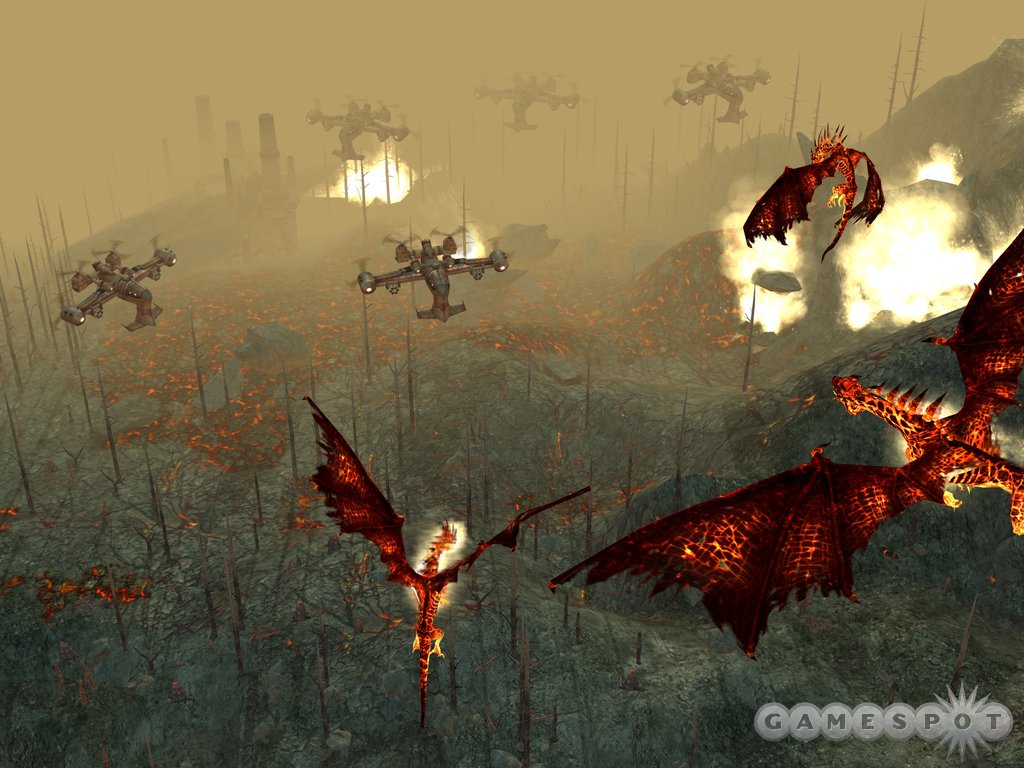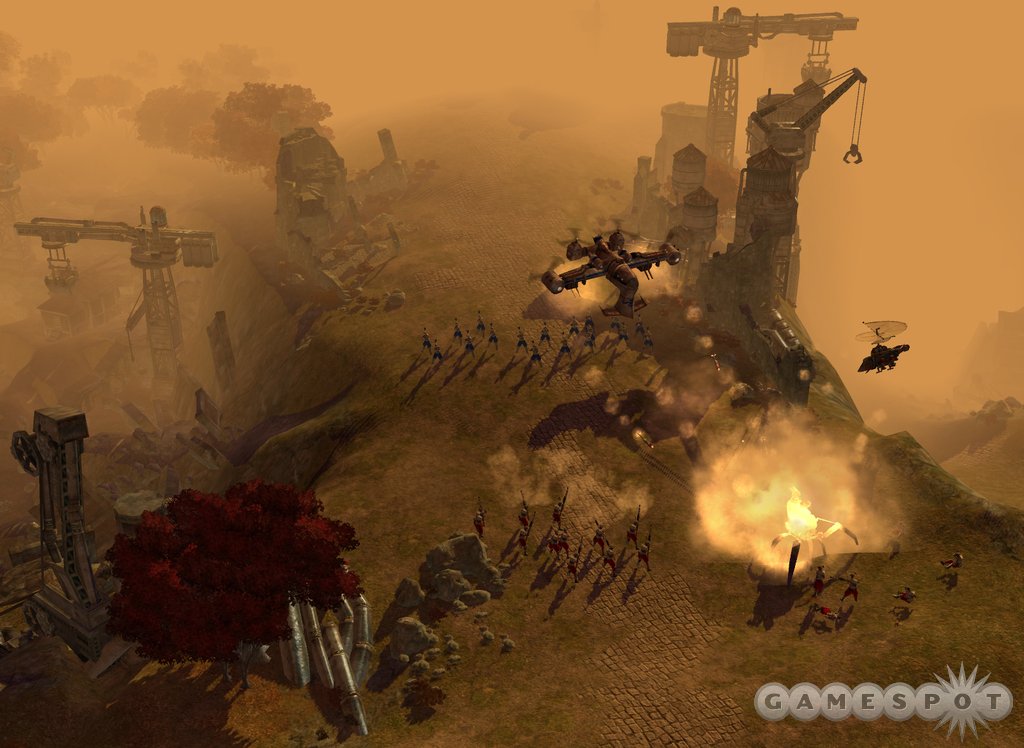Rise of Nations: Rise of Legends Developer Diary #1 - Why Rise of Legends?
Brian Reynolds, president of Big Huge Games, kicks off our designer diary series for this upcoming RTS by explaining why the company shifted from history to fantasy.
Big Huge Games lived up to its name in 2003 when it released Rise of Nations, a historically based real-time strategy game that was also our 2003 PC Game of the Year, which in itself was impressive, especially considering that it represented the company's debut effort. And Big Huge made further big news this year when it announced the follow-up to Rise of Nations with a game that not only builds on its predecessor, but also takes the story in entirely new directions. That game is Rise of Nations: Rise of Legends. Due out in 2006, Rise of Legends looks to combine the excellent and fast-paced gameplay of Rise of Nations and ground it in an entirely new and original fantasy setting that pits magical nations at war against technological nations. In the opening edition of our designer series for Rise of Legends, we got Brian Reynolds, the president of Big Huge Games, to explain why Big Huge Games decided to go in an entirely new direction. Reynolds isn't just the president of the company, either; he's also the lead designer of Rise of Nations and Rise of Legends.

Why Rise of Legends?
Brian ReynoldsPresident, Big Huge Games
So you may have noticed we aren't working on a history game this time! When we finished Rise of Nations and started thinking about our next game, we were a bit torn between two competing forces. On the one hand, we deeply enjoyed making Rise of Nations and realized it deserved a follow-up game; but on the other hand, we had some very creative ideas which were leading us down a less-historical path. This naturally provoked quite a bit of discussion about whether we could satisfy both urges at the same time. Can we do a fantasy game that's still a spiritual successor to Rise of Nations, and if so, how?
Clearly, our answer turned out to be yes, and the result is Rise of Legends. But today I'd like to take a look back on some of those discussions and the way they shaped the product we're creating. To answer the underlying question, "What does it mean to be a Rise game?" we first clearly needed to identify the parts we thought were strongest and best received from Rise of Nations--the features that really made it stand out from the crowd and that our fans will expect to see in any follow-on game, because a feature that wasn't well received could be changed or improved. And at the same time we also needed to ask ourselves if there were any features missing from Rise of Nations that we thought were actually keys to the future of the franchise moving forward.
Looking back on Rise of Nations, it seemed clear that the heart of that product's success could be summed up as "rich and innovative gameplay." That wasn't the only thing Rise of Nations had going for it, but it was the thing which most made the game stand out from the crowd. The specifics of rich gameplay could then be broken down into several very important subfeatures: national borders with their attendant effects on building placement, attrition, etc.; the "capturing" of cities in contrast to the destroying of everything typical in the rest of the genre; the open-ended conquer-the-world campaign system, which gave players real choices at the strategic level rather than just clicking to advance a linear storyline; a rich technology tree allowing players to choose different areas of emphasis; diverse maps and settings, which pose a wide variety of challenges to players; fast-paced multiplayer play (or as we like to say it, "history in on your lunch hour"); and interesting and contrasting nations and nation powers. All of these we knew we wanted to not only include, but expand on for our next game.

On the other hand, we found there were also parts of the game that turned out to be less important or interesting than we had thought they would be. For example, whereas players were generally quite interested in the library with its color-coded tech tracks, having to find and remember a plethora of side upgrades available at other buildings (i.e. the granary, the lumber mill, and so forth) turned out to be a bit overwhelming for many players, while not creating as much deep gameplay value as we'd hoped. Similarly we'd put considerable effort into testing and balancing features, such as alternate victory conditions (wonder timers, territory victory, assassin), but found that in practice most of our actual online players wanted to play more traditional formats (team games, free-for-alls) and would have preferred we put more work into polishing those. It became clear that making a follow-on product is not just about "keeping everything the same"; it's about keeping the best stuff the same and making other things better.
We Built This City on Districts
And there were some key areas we felt we could do better, graphics being a standout. It wasn't that we didn't think graphics were important the first time around, but the realities of developing a brand-new real-time strategy game at a brand-new company inevitably forced us to focus most strongly on gameplay, which is the area we'd identified was going to do the most to set Rise of Nations apart from its competition. So Rise of Nations ended up with good, attractive graphics, completely reasonable compared to other products that released at the same time, but not cutting-edge, blow-your-socks-off graphics. But it seemed to us that graphics can be at least as central to the experience of playing a great strategy game as rich gameplay, and that truly living up to our "Big and Huge" motto meant we needed to get out there on the cutting edge and start, well, cutting! That in particular meant razing our graphic engine to the ground and creating an all-new engine to support the hottest graphics technology (plus the tools to let our artists really shine). 
This graphical imperative also made the idea of a fantasy setting seem very attractive. By unshackling ourselves from the constraints of needing to represent precise and authentic periods and items from human history, we gave our artists a lot of extra room to run. And since we also knew that we didn't want to do a "traditional" fantasy game with orcs, elves, dwarves, and so forth, the setting quickly grew beyond the bounds of just fantasy--it became a game about magic and technology locked in conflict and specifically looking really cool in the process. As it happened, there were several concepts we thought were very cool and visually interesting but didn't seem broad enough to do an entire game about--these became the starting points for our nations. A shelved idea for an Arabian Nights game inspired our Alim nation. Likewise, an idea to do a game about Leonardo Da Vinci and his inventions got steampunked up a bit to become the Vinci nation. Notice also how the immense visual contrast between these two races also enhanced one of our gameplay goals, which is to have interesting and contrasting nations and powers.
After some fairly intensive prototyping, we began to see several areas where our plan to create sharp, innovative gameplay worked very much in harmony with our goal to make the graphics amazing. Take city-building, for instance. Throughout the development of Rise of Nations we were always challenged by the problem of how to "make cities look like cities." With the traditional RTS-building construction paradigm it was always hard to avoid having "cities" just look like clumps of randomly placed buildings. But as the artists created cities, which looked supercolossal and amazing, we needed a new system, and that's when we thought of "city districts." Instead of semi-independent civilian buildings (like university, market, and temple from Rise of Nations) loosely placed around a central point, cities in Rise of Legends have districts built right onto them. They form permanent visual connections and effectively become "part of the city" both visually and in game terms. The different kinds of districts (military, merchant, guild, and palace) each enhance the city in different ways, so a city full of military districts would be a very different place from a city full of merchant districts or one with an equal number of each district. The end result is cities that not only look a lot better, but also provide an interesting new type of gameplay.

Obviously with Rise of Legends not scheduled for release until 2006, there's still plenty of work to be done, but that's the direction we're heading in. The gameplay features our fans know and love from Rise of Nations will be back in expanded form and combined with new innovations. Our graphics engine has been rebuilt from scratch to the point you'll hardly believe it's the same company doing the graphics. Magic and technology will collide with cataclysmic results, and perhaps that's a good metaphor for what we're trying to do in the development of the game: the magic of Rise of Nations-style gameplay meets the technology of cutting-edge graphics, and we think the results will amaze you!
Got a news tip or want to contact us directly? Email news@gamespot.com
Join the conversation